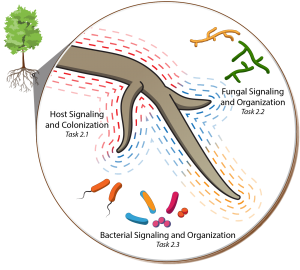Defining the chemical environment and molecular signals that influence community structure and function
Understanding how the local environment in the rhizosphere influences and is influenced by community composition and function represents a key knowledge gap and is the focus of Objective 2.
Objective 2 Tasks
- Task 2.1 – Understanding the role of the chemical and physical environment on microbial community interactions and structure.
- In this task, we will develop and refine strategies for sampling the local chemical environment around the host plant.
- Task 2.2 – Determining host and microbially produced metabolites that impact microbial community interactions and structure.
- the goal of this task is to characterize the mechanism by which the PipR system mediates bacterial association with plants.
- Task 2.3 –
- We will focus on understanding the mechanisms used by fungi to communicate with each other, and with the host plant, to promote plant association and community development.

Objective 2 overview. Task 2.1 will examine the host derived factors that structure the community; Task 2.2 will examine aspects of bacterially-derived metabolites involved in community structuring; and Task 2.3 will examine fungal signaling mechanisms.
Figure: Overview of the subtasks in Aim 2.

